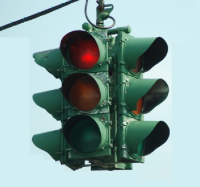As I’m driving, I have explored routes in Eugene that the traffic lights are synchronized. I even know that if I miss a certain traffic light, I can turn and follow another route to get to my destination quicker, safer and with less wear and tear on the vehicle. Every time you stop, you use more brake material and waste fuel and time.
The good news about Eugene is the city has spent much time and money in traffic light controls. They are “smart” controls, knowing the time of day and “counting” vehicles on the road. How? There are two ways of counting vehicles I know of, the most common is in ground loop detectors. These are put into the payment and detect metal. There may be one to four loops in a lane at a stop light, counting vehicles. The more vehicles detected, the longer the light will stay green. If there’s a low traffic count, the lights change quickly.
The other type is an infrared motion detector. The most visible one locally is the camera looking north where I-105 meets 7th avenue. These also count the vehicles so the controllers of traffic light timing can make informed decisions.
Most traffic lights in Eugene “report” to the central controller at the city shop so they can synchronize the traffic light and monitor the current traffic situation.
Most traffic lights on major routes also have a detector that knows when an emergency vehicle is approaching and will change the traffic light to green ahead of it.
I greatly appreciate the traffic light controls in Eugene, all the more when traveling to cities with “dumb” traffic lights.
Other recent road safety upgrades include sensors that watch road surface temperature, the humidity and air temperature. The stations are located throughout the city, one is the Southwest hills, and another is on the Ferry Street Bridge and another is soon to be installed is one the Maxwell overcrossing of the rail yards. These will help the city crews to determine when de-icing or snow plowing is needed.
Please note, some of these devices look like video cameras, but are not so please don’t get paranoid that big brother is watching you. These devices make driving safer, smoother and more fuel-efficient. Hats off to our traffic control team.
Diagnostic dilemmas
One of the greatest challenges in auto repair is diagnosing modern engine, transmission and body control electronics. The most common question we encounter from customers is how much is it to repair a “check engine” light, a poor running engine, a transmission or even a security system that is not working correctly.
The honest answer is you don’t know until you know. We have logical steps to follow, checking and eliminating different possibilities. A good diagnostician will consider the most common logical possibilities and go through and test each one and eliminate those as they continue the journey until the problem is found. This process gets even more complicated if there is more than one problem, the problem is intermittent or in recent example, the problem is “unnatural” (someone goofed up on it when the earlier repair work was done).
A Volkswagen came into our shop a few weeks ago with the “check engine” light on. After spending a quoted hour on “running” the electronic fault from the car’s computer and checking those codes against known problem, we still didn’t have an answer. We had to call the customer back and ask permission for more time. In most cases, we know in one to two hours of diagnostic time what the vehicle needs but in this case, even after hours of running test and checking major components, we were still not sure what the problem was but had a good idea the cam timing was off. This was another three hours of time to check with another six hours to repair. (The transmission has to come out on this vehicle to get to the timing chain)
The customer was not happy about not having a definite answer on this recently purchased car and I understand his frustration. What created the frustration was not our skills but the problem’s complexity and the major expense to repair it.
The bottom line is we don’t know what it is going to cost to diagnose and repair a problem until we identify the problem. We can guess based our past experiences but as always, guessing is just that and not accurate. There are logical steps and the more steps needed, the higher the diagnostic and repair costs will be. Please remember, an auto repair shop has no control over what is broken, we just give you the news, good or bad!